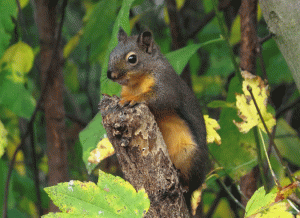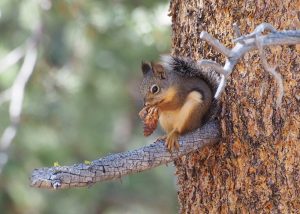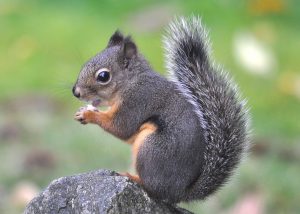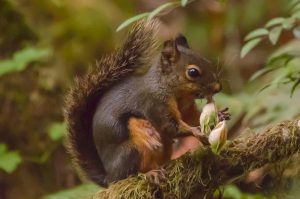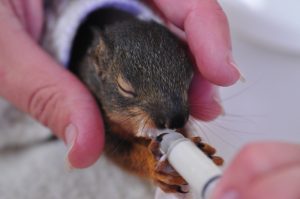Douglas Squirrel
The loud squirrel is an attentive and agile species. They have cute tuft around the ears during the winter.
Scientific Information
| Kingdom | Animalia |
| Phylum | Chordata |
| Class | Mammalia |
| Order | Rodentia |
| Family | Sciuridae |
| Genus | Tamiasciurus |
| Scientific Name | Tamiasciurus douglasii |
| Also Known as | Douglas’s squirrel, Douglas’ squirrel, pillillooeet, pine squirrel or chickaree |
| Description | Size: Around 12 in (33 cm) Color: During the summer, the back is greenish brown while the belly and chest are pale orange. During the winter the coat becomes browner and the chest and belly become grayer Weight: 5.29-10.5 oz (150-300 g) |
| Distribution | United States and Canada |
| Habitat | Coniferous of the pacific coast |
| Subspecies | 1. T. d. douglasii 2. T. d. mollipilosus |
| Sounds and Call | ‘Bauf, bauf, bauf’, ‘burr’, and ‘chir’ |
| Lifespan | 5-6 years |
| Diet | Pine seeds, twigs, sap, buds, leaves, mushrooms, acorns, berries, nuts, fungi, bird eggs, arthropods, and nestlings |
| Adaptation | 1. The claws are strong enough to have a good grasp of bark. 2. Their tail helps them balance the body when they climb the trees vertically. It is also used as an umbrella and a warm coat during the winter. 3. Through their whiskers on the nose, chin, and around the eye zone, they sense the surrounding. |
| Predators | Owls, northern goshawks, bobcats, domestic cats, and American martens |
| IUCN Conservation Status | Least Concern |
Behavior
- Except for babies and their mothers, these squirrels are solitary.
- They prefer abandoned nests of woodpeckers and other birds.
- Douglas squirrels are diurnal.
- In order to protect their territory, the squirrels produce a large alarming call to ward off other animals.
Mating and Reproduction
The mating season starts from February and last till August but most mating occurs between March to June. Female squirrels give birth to litters, each containing 4-6 kittens.
Life Cycle
Young squirrels are born blind and they do not have any fur on them. They weigh 13-18 g (0.4-0.6 oz). They start growing fur when they are around 18 days and start opening their eyes during 26-36 days. The mother starts weaning them when they are 6-9 weeks old and it continues for more 3 months. During 4-6 months of age, they become young but stay with their families. They become adult attaining sexual maturity when they reach 8-9 months.
Interesting Facts
- While communicating with other closely-related species, the squirrels use their tail as a flag.
- They keep on chewing things, especially twigs to sharpen and trim their teeth.
References
- https://animaldiversity.org/accounts/Tamiasciurus_douglasii/#lifespan_longevity
- https://animalia.bio/douglas-squirrel
- http://www.nhptv.org/natureworks/douglassquirrel.htm/
- http://naturemappingfoundation.org/natmap/facts/douglas_squirrel_712.html
- https://thewebsiteofeverything.com/animals/mammals/Rodentia/Sciuridae/Tamiasciurus/Tamiasciurus-douglasii.html
Published on July 6th 2019 by Sahana Kanjilal under Coniferous Forest Animals.
Article was last reviewed on 5th December 2024.


